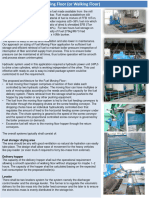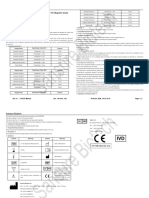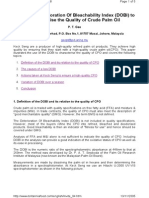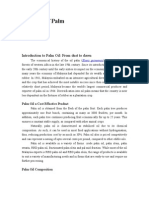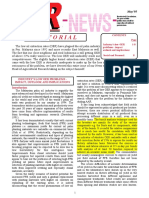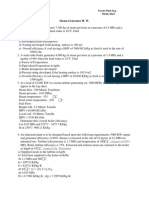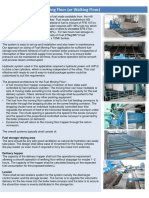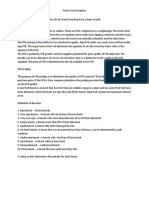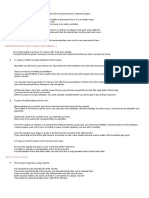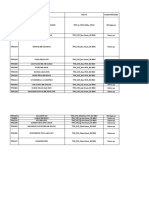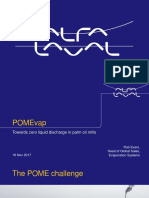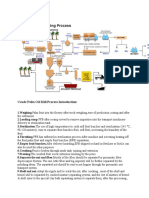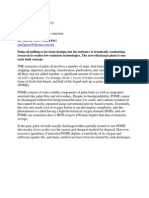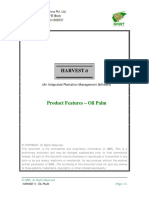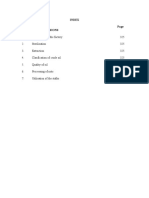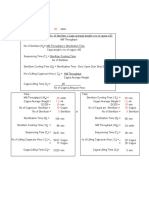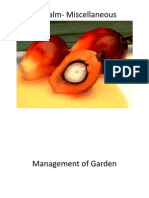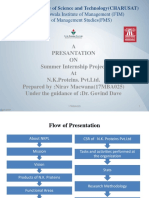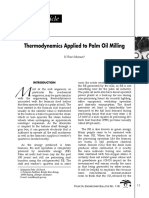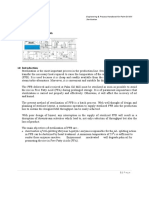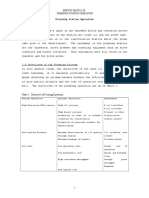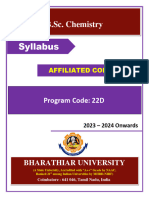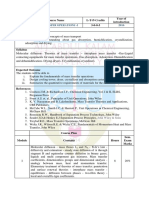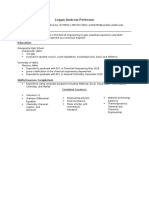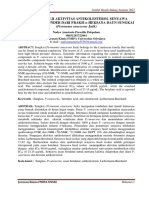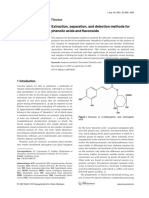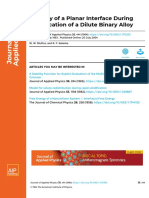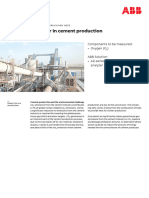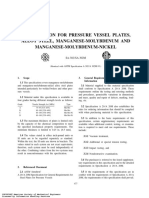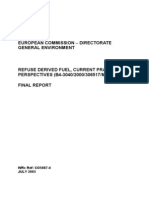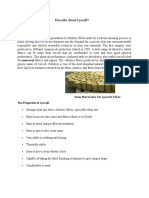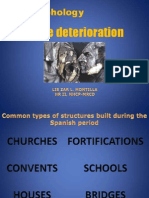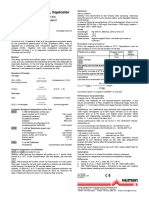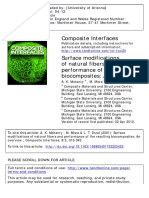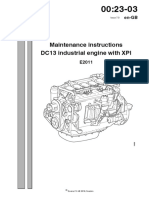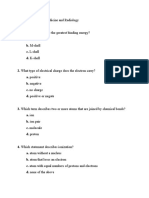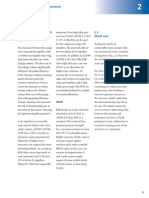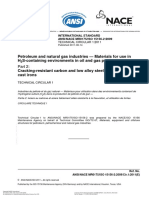Poeb130 Yosri
Poeb130 Yosri
Uploaded by
Na'imusyahmi GhazaliCopyright:
Available Formats
Poeb130 Yosri
Poeb130 Yosri
Uploaded by
Na'imusyahmi GhazaliOriginal Title
Copyright
Available Formats
Share this document
Did you find this document useful?
Is this content inappropriate?
Copyright:
Available Formats
Poeb130 Yosri
Poeb130 Yosri
Uploaded by
Na'imusyahmi GhazaliCopyright:
Available Formats
Feature Article
Screw Press Operation Optimisation for Oil and
Kernel Recovery Enhancement
Yosri, M S*; Syahril Anuar, M R*; Nik Suhaimi, M H*; Muhammad Zaidy, A*; Mohammed
Faisal, M Y* and Ahmad Jaril, A*
*Processing Technology, SIME DARBY Research Sdn Bhd,
R&D Centre - Carey Island, Lot 2664, Jalan Pulau Carey,
42960 Pulau Carey, Kuala Langat, Selangor.
E-mail: yosri.mohd.siran@simedarbyplantation.com
ABSTRACT the designated press throughput. The performance
Pressing operation is an interesting subject of of the press does not only depend on the design,
discussion as it involves two crucial process but also influenced by process variables, as well
losses parameters namely, oil loss and broken as wear and tear. The overall operation of pressing
nuts. Though zero loss in palm oil milling is station consists of digestion, pressing, dilution and
impossible, this does not mean that effort screening. In conventional palm oil mill, the fruits, so
should not be given to find ways in reducing called (MPD) mass passing to digester are digested
it even though the losses is already within at 90oC for about 20 min. For a 15 t throughput
specification. It must be noted that higher press, typical volume of the digester is about 3500
process losses will lead to higher operating litres. During digestion, the oil-bearing cells are
cost and eventually be used as indicator ruptured and this will facilitate oil extraction during
that the processing is not being carried out pressing and clarification. Digestion is carried
efficiently. Digester operation, main screw out by stirring effect from five stirring arms that
speed, pressure cone setting and maintenance are installed alternately in opposite directions
are among the crucial factors that affect where the fruits are forced to move upward and
the pressing operation. In addition to that, downward (due to the ‘lifting’ effect of the stirring
operator’s effort and his responsiveness arms). This causes the fruits to strongly rub against
on mash and crop condition are crucial for each other, leading to severe bruising of the fruits
achieving good press operation. This article and resulting in breaking down of the pericarp
reviews few variables that affect the screw into mash. The oil bearing cells are subsequently
press operation performance. ruptured. The digested MPD mash is then fed into
the press by the digester’s expeller arm. The press
operation is controlled through adjusting the main
INTRODUCTION screw speed and the pressure of the cones at the
discharge end of the screw press. Two parameters
Screw press operation is one of the most important that are monitored to indicate press performance
processes in palm oil mill. It is responsible for and efficiency are the percentage of broken nuts
extracting oil from digested mesocarp with and oil losses in press cake. Pressing operation
consideration of the following objectives, minimum with broken nuts percentage of below 20% and oil
oil loss in pressed fibre and minimum nut breakage at losses (wet basis) of below 4.5% is desirable.
[ 18 ] Palm Oil Engineering Bulletin No. 130
Screw Press Operation Optimisation for Oil and
Kernel Recovery Enhancement
TABLE 1. VARIABLE AFFECTING THE SCREW PRESS OPERATION
No. Factors Variable
1 Raw material/FFB • Ripeness
• Lag time between harvesting and processing
• Contamination
• Fibre/nut ratio
2 Sterilisation • Sterilisation cycle
• Sterilisation method
3 Digester parameters • Digester level
• Digester drainage
• Temperature
4 Press parameters • Main screw speed
• Cone pressure
TABLE 2. PRESSING USING STORK SCREW PRESS FOR DIFFERENT TYPES OF CROP
Crop Main screw Feed screw Load setting OLDB (%) Broken nut (%)
(rpm) (rpm) (Ampere)
Overnight 12 18 36-38 8.52 30.35
Fresh 12 18 36-38 8.14 19.87
Note: Oil loss dry basis (OLDB).
Study done at Diamond Jubilee Mill (2002).
VARIABLES AFFECTING PRESS the factors affecting screw press operation are listed
PERFORMANCE in Table 1 with only the main factor to be discussed
in details.
There are many factors that contribute to the good
performance of pressing. Though process at pressing CROP CONDITION AND BUNCH
station is optimised, it does not guarantee that
COMPOSITION
oil losses and nuts breakage are at lowest range.
Experienced press operator knows that suitable
Upstream processes such as sterilisation, crop
screw press setting should be used in accordance
condition and fresh fruit bunch (FFB) compositions
to crop condition. In general, overnight crops require
could also contribute significant impact to the
lower pressing pressure as compared to fresh crop.
performance of the screw press operation. Most of
Figure 1. Sterilisation of fresh fruit bunches (FFB).
Palm Oil Engineering Bulletin No. 130 [ 19 ]
Feature Article
This is due to the fact that fruits of overnight crop Previous study shows that the optimum nut to fibre
are softer than fresh crop and thus easily crushed ratio for screw press operation is 45:55 (Lokman,
during pressing. Study has shown that using the 2003).
same press setting for both fresh and overnight crop
will result in higher losses for the latter, as shown in STERILISATION
Table 2.
Sterilisation is a crucial process that if not properly
In the case of overnight crop, the fibre has lost its carried out will affect most of the downstream
elasticity and strength thus increase the opportunity processes during palm oil milling (Figure 1).
for nuts to come into contact with each other as Sterilisation helps in loosening the fibre from the
the pressing pressure increases. This explained nuts during pressing operation. It also ensures the
why the broken nuts percentage for overnight crop oil cells are more easily ruptured during digestion
is higher. If the mash has high proportion of nuts and pressing for good oil recovery. Over-sterilisation
(nut to fibre ratio), it will also result on the same will lead to over-dehydration of the nuts that makes
outcome. In addition to that, fibre will be trapped it less elastic and easier to crack during pressing
in the free space between the nuts and oil that has (Southworth, 1982). Sterilisation period must be
been released adsorbed to it, resulting to higher oil adjusted according to different types of crop, i.e.
losses (Olie, 1974). In this case, it is recommended shorter sterilisation for overnight crop to avoid over
to add fibre into the sterilised fruits for optimum sterilisation of bunches.
pressing results. When the nuts ratio is low, the cake
will have higher friction resistance caused by fibre to On the contrary, under-sterilisation will reduce
fibre contact. The force or pressure exerted during oil liberation from the cells due to inadequate
pressing cannot be transmitted deep enough into the conditioning of fibre cell. Thus, the retained oil that
press cake, resulting in higher oil losses (Olie, 1974). is still attached to the fibre is carried over to fibre
cyclone and contribute to higher oil.
Figure 2. The digester is used to mash the sterilised fruits.
TABLE 3. PERCENTAGE OIL LOSS DRY BASIS IN RELATION TO DIGESTER LEVEL
Digester level Main screw (rpm) Digester temp (oC) Load setting (Ampere) OLDB (%)
¾ 12 95 24-26 7.91
½ 12 95 24-26 9.85
[ 20 ] Palm Oil Engineering Bulletin No. 130
Screw Press Operation Optimisation for Oil and
Kernel Recovery Enhancement
TABLE 4. EFFECT OF DIGESTER LEVEL IN RELATION TO STIRRER ARM CONDITION
Percentage oil loss % (dry basis)
n = 10 Level in digester
Half Full
Stirrer Arm Good condition 8.02 7.64
Condition Poor condition 9.45 8.54
Percentage broken nut %
n = 10 Level in digester
Half Full
Stirrer Arm Good condition 11.07 14.28
Condition Poor condition 15.59 19.10
TABLE 5. THE EFFECT OF DIGESTER DRAINAGE ON OIL LOSS AND BROKEN NUT
n= 5 Oil loss in press fibre (%) (dry) Broken nut (%)
No drainage 7.46 13.56
Full drainage 7.25 13.91
Figure 3. Hot water injection into digester.
DIGESTION filled and maintain with more than three quarter of
its designed volume to ensure good performance
Digester Level (Figure 2).
Digestion has direct effect on the performance
of pressing operation. As its main task is to rupture The volume of the mash in the digester is directly
the oil bearing cells and loosen the pericarp from related to the stirring effect efficiency. According to
the nuts, inefficient digestion will eventually leads Stork Palm Oil Review, the stirring effect was at 55%
to oil still being trapped in the cells and could not efficiency if the filling level of the digester was at
be extracted during pressing. Digester must be 75% and reduced to 35% efficiency for 60% filling
Palm Oil Engineering Bulletin No. 130 [ 21 ]
Feature Article
TABLE 6. EFFECT OF HOT WATER INJECTION INTO DIGESTER
Hot water injection into digester
No. (n=76) OLWB (%) OLDB (%) NOS (%) VM (%) Fibre Nut Ratio
Average 4.20 6.38 61.79 34.00 53:47
SD 0.68 1.05 3.90 3.94 -
Hot water dilution into oil gutter
No. (n=49) OLWB (%) OLDB (%) NOS (%) VM (%) Fibre Nut Ratio
Average 5.04 8.30 55.80 39.16 53:47
SD 0.95 1.71 3.83 3.59 -
level. The immediate result of the stirring inefficiency accordance to Stork’s digester design, the clearance
is the increased in oil losses. In the event of high between the tips of the stirring arms and the liners
broken nuts and high oil loss in fibre, the first thing must not exceed 10 mm.
to be taken care of is the digester filling level. Most
of the time, when the optimum digester filling level The stirring arms and the expeller blades should
is achieved, oil loss will be reduced and the only not become too round (which indicates worn out) at
problem to be tackled is broken nuts. Likewise, it is
TABLE 7. EFFECT OF MAIN SCREW SPEED ON OIL LOSS
meaningless to troubleshoot high oil loss by adjusting AND BROKEN NUT IN PRESS CAKE
screw press setting without solving the digester Oil loss (%) (dry basis)
filling level first. Results from trials carried out using Main screw speed
CB Screw Press (P15 model) for percentage oil loss 9.6 rpm 12 rpm
in relation to digester filling level is shown in Table 3. Load setting 36-38 amp 6.43 8.03
38-40 amp 7.48 7.73
Normally, low digester volume will result in Average 6.95 7.88
low retention time of the mash and consequently
Broken nut (%)
inefficient stirring effect. Nowadays, the average
Main screw speed
retention time for digester has been reduced to 9.6 rpm 12 rpm
about 18 to 22 min due to increased screw press Load setting 36-38 amp 36.90 39.89
capacity. Apart from low digester level, worn stirring 38-40 amp 39.15 42.81
arms can also bring down the stirring efficiency. In Average 38.02 41.35
Figure 4. The screw presses are used to extract oil after digestion process.
[ 22 ] Palm Oil Engineering Bulletin No. 130
Screw Press Operation Optimisation for Oil and
Kernel Recovery Enhancement
TABLE 8. EFFECT OF MAIN SCREW SPEED ON OIL LOSS AND BROKEN NUT IN PRESS CAKE AT SUA BETUNG MILL
Main screw speed (rpm) No. trial Oil loss (% wet) Broken nut (%)
7.5 15 4.44 11.27
8.5 19 4.48 11.12
TABLE 9. EFFECT OF PRESS CAGE PERFORATION SIZE ON OIL LOSS AND BROKEN NUTS
Perforation size (mm) Main screw (rpm) Broken nut (%) OLDB (%)
2 15 18.12 11.14
3/4 tapered 15 18.94 9.71
the tips nor should the ‘lifting’ of the stirring arms and reduces pressing efficiency. In earlier Stork’s
decrease too much. This must be monitored from digester design, it is expected about 22% - 32% of
time to time. Currently, replaceable stirring arm’s tip digester volume is discharged before being fed into
is being used for easier maintenance (Ravi, 2002). the screw press. The oil will be discharged through
The study on effect of digester level in relation to the drainage at the bottom of the digester and at the
stirrer arm condition on oil loss and broken nut is perforation body of the feed-screw press. The study
shown in Table 4. on effect of digester drainage on oil loss and broken
nut is shown in Table 5.
Digester Drainage
Oil drainage system is another important feature Hot Water Injection into Digester
of digester. If the oil is not released from the digester, Trial was conducted to improve press operation
the stirring arms will agitate the oil for a considerable by introducing hot water injection into digester as
period of time and emulsion will be formed which tabulated in Figure 3. This new method is carried
will reduce the oil extraction efficiency. In addition to out by injecting hot water at the lower side of the
that, excessive oil in screw press will act as lubricant digester to maximise the removal of free oil from the
Figure 5. The recommended cone pressure and motor load setting for three types of screw presses.
Palm Oil Engineering Bulletin No. 130 [ 23 ]
Feature Article
Figure 6. Maintenance of screw press.
fruit mash resulting in less oil entering the screw In general, increasing the main screw speed will
press. The number of drainage holes at the bottom increase mill throughput and oil losses. Increasing
plate were increased to improve oil removal. This cone pressure does not affect throughput but will
new method will maintain the dilution ratio, where reduce oil loss and increase kernel loss (Southworth,
the difference lies in introducing dilution before the 1982). Nevertheless, it is not advisable to simply
press operation. adjust main screw speed every time the oil loss or
broken nut ratio exceeded the allowed specification.
Trial conducted at one of the mill (Table 6) Most of the time, good screw press operation depends
showed significant reduction in oil loss, at 4.20% on alertness and responsiveness of the operator
(OLWB) and 6.38% (OLDB) against conventional towards the screw press discharge conditions. The
method at 5.04% (OLWB) and 8.30% (OLDB), operator must always check the wetness of the press
respectively. There was no significant impact cake and adjust the pressure setting accordingly. If
on non-oily solid (NOS) and volatile matter (VM) the mash looks oily, the operator needs to check the
ratio. The results also showed that there was no temperature and increase cone pressure. If the mash
significant difference in oil loss in sludge. Spin test looks dry and contains crushed kernels, the operator
indicated that there was no significant difference should reduce the cone pressure.
in formation of emulsion in the oil for both dilution
methods. Main Screw Speed
The setting of main screw is very crucial as it
Temperature does not only influence the oil loss and broken nut
The temperature of the digester must be in press cake but also mill’s throughput. Thus, it is
maintained high at 90oC to reduce viscosity of the important to set the main screw at the right speed to
crude oil in order to facilitate oil removal at the bottom attain the mill designated throughput and optimum
of the digester and improve pressing operation. It will oil extraction. Study on the effect of main screw
also increase the elasticity of the nuts thus minimise speed and load setting (amp) on oil loss and broken
nut breakage in the screw press (Maycock, 1987). nut was conducted earlier at Diamond Jubilee Mill.
The results are shown in Table 7.
Pressing Operation
There are many combinations of setting for the Generally, the study showed that low main screw
main screw speed and cone pressure that should be speed and low load setting resulted in lower oil loss
considered for good pressing operation (Figure 4). and broken nut. Another study on different main
[ 24 ] Palm Oil Engineering Bulletin No. 130
Screw Press Operation Optimisation for Oil and
Kernel Recovery Enhancement
screw speed was conducted at Sua Betong Mill. The worm screw and press cage when both are new
trial was to compare the speed of 8.5 rpm with 7.5 must not be more than 5 mm and should not be
rpm with cone pressure maintained between 50 bar allowed to exceed 12 mm clearance to minimise oil
to 60 bar. The result is shown in Table 8. It was found loss and nut breakage (Wilson, 1993).
that there was no significant effect on oil loss and
broken nut when the main screw speed was reduced MAINTENANCE
to 7.5 rpm from the earlier setting of 8.5 rpm.
Maintenance of screw press is detrimental to the
Hydraulic Cone Pressure performance of pressing operation (Figure 6).
Increasing the hydraulic cone pressure could Indications such as reduced throughput, high
increase the pressure exerted to the cake, which broken nuts and oil loss must be observed not only
could reduce oil loss. However, very high cone on the operation setting but also as maintenance
pressure could cause kernel to pulverise resulted element. It is important to overhaul when necessary
in lauric acid contamination. Ideally, optimum cone as higher loss will usually incur higher cost than
pressure should not be set higher than 70 bar to the cost to replace press cage or worm screw. The
obtain acceptable oil loss in press cake as well as recommended period to change the worm screw
broken nut of less than 20%. At high cone pressure, is 800 hr for normal material and 1000 hr for 3%
the kernel could be crushed into powder and produce chromium material. However, it is expected that
kernel oil which would contaminate the crude oil the life span of the worm screw could be reduced
stream. The lauric acid ratio in CPO production due to poor condition of FFB processed with higher
should be controlled to lower than 0.4%. contaminants.
It is recommended that the ideal operating CONCLUSION
hydraulic pressure is between 50 bar - 70 bar with
the motor load setting at 35 amps - 40 amps, 45 Being competitive means being able to produce
amps - 50 amps and 60 amps - 65 amps respectively products of required quality and most importantly at
for P10, P15 and P20 screw presses, as shown in lowest cost. Pressing station is where loss can easily
Figure 5. be out of control if certain process conditions were
not given adequate attention. Digester operation,
Press Cage main screw speed, cone pressure setting and
Many assumptions have been made on the maintenance are among the crucial factors that affect
optimum numbers and perforation size of the press pressing operation. In addition, operator’s effort and
cage for good pressing operation, but so far no responsiveness to the mash and crop condition are
proper study has been made to justify any claim on also important for good pressing operation.
the matter. A study was conducted to determine the
effect of cage perforation size on the oil loss and REFERENCES
broken nuts percentage (Table 9).
CB Industrial Product Sdn. Bhd. (2001). CB Screw
From the table, it can be seen that oil loss was Press & Digester. Operation Manual.
reduced when the press uses 3 mm - 4 mm tapered
perforation size. This may be due to easier oil release Kamaludin, H (1991). The Pressing Station. Training
through bigger perforation size. Clearance between Course for Oil Mill Supervisors, MPOB.
Palm Oil Engineering Bulletin No. 130 [ 25 ]
Feature Article
Lal, V K (1992). Quality of East Malaysian crude palm Ravi Menon, N (2002). Quality aspects of milling.
oil – Pan-century edible oils’ experience. PORIM Palm Oil Engineering Buletin, No. 63: 17.
Bulletin. p. 29.
Southworth, A (1982). Oil extraction by pressing.
th
Lokman, S (2002). Pressing, 9 Factory Conductors’ PORIM Regional Workshop on Palm Oil Mill
Course, GHRSB, 17 – 29 March 2003. Technology and Effluent Treatment. Kuala Lumpur.
17-18 August 1982.
Maycock, J H (1987). Palm Oil Factory Process
Handbook Part 1. PORIM. p. 35-49. Stork Palmoil Review, Digester (1). November 1960.
Olie, J J (1969). Some factors influencing the Stork Palmoil Review, Digester (2). January 1961.
bleachability of palm oil. Proceedings of a
Symposium, ISP. Kuala Lumpur. p. 36. Stork Palmoil Review. The Correlation between Press
Cake Components and Losses of Oil in Fibre. March
Ravi Menon, N (2002). Evolutionary changes in 1961.
milling technology – Part II. Palm Oil Engineering
Buletin, No. 62: 16-17. Stork (1968). Operation, control, maintenance of
screw press. Instruction Manual.
[ 26 ] Palm Oil Engineering Bulletin No. 130
You might also like
- M. Ichsan 2ndpomi - Oil Losses Max 1%, Why NotDocument47 pagesM. Ichsan 2ndpomi - Oil Losses Max 1%, Why Not82hf95qjsy100% (1)
- Biomass Boiler Fuel Moving Floor or Walking Floor - 5ae5483f7f8b9ae03d8b458cDocument7 pagesBiomass Boiler Fuel Moving Floor or Walking Floor - 5ae5483f7f8b9ae03d8b458cDarek Tymoszuk100% (2)
- Manual-S1006E-Extraction KitDocument2 pagesManual-S1006E-Extraction Kitdanang setiawan100% (2)
- Of Daily Grading TBS Tanggal 09-April-2023Document88 pagesOf Daily Grading TBS Tanggal 09-April-2023Nabila 12No ratings yet
- Oer BoosterDocument8 pagesOer Boosteredison58100% (1)
- Deterioration of Bleachability of Palm Oil MillDocument5 pagesDeterioration of Bleachability of Palm Oil MillEffy SaifulNo ratings yet
- Refinery of Palm OilDocument36 pagesRefinery of Palm Oildoshi_ritesh100% (6)
- Significance of Oil Extraction Rate Efficiency in A Palm Oil MillDocument4 pagesSignificance of Oil Extraction Rate Efficiency in A Palm Oil MilleanguuNo ratings yet
- OER and Total LossesDocument6 pagesOER and Total LossesAster100% (1)
- MPOB Sterilizer Process ControlDocument9 pagesMPOB Sterilizer Process ControlgerrykhangNo ratings yet
- Introduction of Palm Oil Press MachineDocument2 pagesIntroduction of Palm Oil Press MachineChia PeterNo ratings yet
- Rapeseed and Canola Oil: Production, Processing, Properties and UsesFrom EverandRapeseed and Canola Oil: Production, Processing, Properties and UsesNo ratings yet
- Challenges Facing The Palm Oil IndustryDocument5 pagesChallenges Facing The Palm Oil Industryeanguu100% (1)
- FFB Decoring Technology Revolutionizes Palm Oil Milling ProcessDocument17 pagesFFB Decoring Technology Revolutionizes Palm Oil Milling ProcesseanguuNo ratings yet
- Poeb94 LohDocument10 pagesPoeb94 LohTina Rin100% (2)
- Bunch Analysis - OERDocument8 pagesBunch Analysis - OERRondoNo ratings yet
- Processing of Palm Oil Mill Wastes Based On Zero WDocument9 pagesProcessing of Palm Oil Mill Wastes Based On Zero WSatria MandalaNo ratings yet
- Rolek Palm Nut CrackerDocument15 pagesRolek Palm Nut CrackerAyo Abe LighthouseNo ratings yet
- EH - Topic 1 Reception - Final Draft 300413Document5 pagesEH - Topic 1 Reception - Final Draft 300413Amin Buhari Md Zain100% (1)
- Enzymes For Improving Oil Yield in Palm Oil Extraction: World Congress On Industrial Biotechnology, MontrealDocument29 pagesEnzymes For Improving Oil Yield in Palm Oil Extraction: World Congress On Industrial Biotechnology, MontrealRonel MendozaNo ratings yet
- Poeb118 PDFDocument56 pagesPoeb118 PDFDeny Handoko100% (1)
- Palm Oil Mill EffluentDocument6 pagesPalm Oil Mill Effluentankitsaxena123100% (2)
- Chapter 3 Technical FeasibilityDocument88 pagesChapter 3 Technical FeasibilityAnissa Munira100% (3)
- Steam Generator H. WDocument2 pagesSteam Generator H. Wمصطفى أحمد عبد الرزاق هاديNo ratings yet
- Unit 3 (MPOB)Document62 pagesUnit 3 (MPOB)ShivaniNo ratings yet
- Palm Oil MillDocument11 pagesPalm Oil MillEitrah Tasnim Mohamat Kasim100% (2)
- Fresh Fruit Bunch Reception & Quality Dipom 2024Document58 pagesFresh Fruit Bunch Reception & Quality Dipom 2024Muhammad Syukry100% (2)
- Fuel Walking Floor and Boiler Fire GrateDocument3 pagesFuel Walking Floor and Boiler Fire GrateMaheswara Prihat AyodyoNo ratings yet
- Fresh Fruit ReceptionDocument2 pagesFresh Fruit ReceptionhaysnamripNo ratings yet
- Modern Oil Palm CultivationDocument12 pagesModern Oil Palm CultivationLip Hock Chan100% (1)
- Development of A Palm Fruit Bunch Chopper and Spikelet StripperDocument7 pagesDevelopment of A Palm Fruit Bunch Chopper and Spikelet Stripperinventionjournals100% (1)
- PD Topic 2Document23 pagesPD Topic 2NityantiniNo ratings yet
- Cpo MillDocument13 pagesCpo MillHendi HendriansyahNo ratings yet
- Chemistry and Biochemistry of Palm OilDocument52 pagesChemistry and Biochemistry of Palm Oiljayengsumangat100% (2)
- COMPETENCY - BINU As of AUG 2022Document8 pagesCOMPETENCY - BINU As of AUG 2022Suhada DaudNo ratings yet
- C20-Rob EversDocument17 pagesC20-Rob EversCheong Wen YuanNo ratings yet
- Crude Palm Oil Mill Process IntroductionDocument2 pagesCrude Palm Oil Mill Process IntroductionMarcel MrcNo ratings yet
- Palm Oil Mills Targets Zero EmissionDocument5 pagesPalm Oil Mills Targets Zero EmissionscreenscreamerNo ratings yet
- Steriliser Type 2Document17 pagesSteriliser Type 2Amin Buhari Md Zain100% (1)
- Mechanical Properties of Oil Palm Fibre-Reinforced Polymer Composites: A ReviewDocument33 pagesMechanical Properties of Oil Palm Fibre-Reinforced Polymer Composites: A ReviewjaviergagocampusanoNo ratings yet
- Top Edible Oil ProductionDocument16 pagesTop Edible Oil Productionabelteshale2244100% (1)
- Palm Oil Fresh Fruit Bunches To Palm Kernel ExpellerDocument4 pagesPalm Oil Fresh Fruit Bunches To Palm Kernel ExpellerSafwan Ghafar100% (1)
- Novaflow POM Industry Brochure PDFDocument36 pagesNovaflow POM Industry Brochure PDFJulhamEfendi100% (1)
- Oil Palm FeaturesDocument34 pagesOil Palm FeaturesLiew Kiat ShingNo ratings yet
- Monggana Volume 2 General Conclusion IndexDocument1 pageMonggana Volume 2 General Conclusion IndexAzaharimahadiNo ratings yet
- Information About Oil Palm NutritionDocument28 pagesInformation About Oil Palm Nutritionquepos09100% (7)
- Energy BalanceDocument6 pagesEnergy BalanceAnissa Munira100% (2)
- Pre CleanerDocument8 pagesPre CleanerKhairi MohammadNo ratings yet
- 1 Q Order Digester & Press Parts CBDocument4 pages1 Q Order Digester & Press Parts CBrendraNo ratings yet
- Design and Analysis of Energy Efficient IntegratedDocument9 pagesDesign and Analysis of Energy Efficient IntegratedAbyan100% (1)
- Conveyor Design DetailDocument6 pagesConveyor Design DetailAzaharimahadiNo ratings yet
- Oil Palm - MiscellaneousDocument58 pagesOil Palm - MiscellaneousPallavi ShigwanNo ratings yet
- 17mba 025Document42 pages17mba 025Er Aks PatelNo ratings yet
- Thermodynamics Palm Oil MillDocument9 pagesThermodynamics Palm Oil MillWilliam MansoNo ratings yet
- Module 3 3rd Edition 2016 08 Oil PlamDocument57 pagesModule 3 3rd Edition 2016 08 Oil PlamjingsiongNo ratings yet
- Assisten Teknik ADocument68 pagesAssisten Teknik AgreenaksesNo ratings yet
- Steriliser Type 1Document21 pagesSteriliser Type 1Amin Buhari Md Zain100% (2)
- List Drawing, The NEWDocument92 pagesList Drawing, The NEWRabindranath Hendy TagoreNo ratings yet
- Processing Station - Part 1 (Mpob HQ 21711)Document56 pagesProcessing Station - Part 1 (Mpob HQ 21711)Ameen Zenn100% (2)
- Hydrogen Production TechnologiesFrom EverandHydrogen Production TechnologiesMehmet SankirNo ratings yet
- Pressing StationDocument8 pagesPressing StationArifalNo ratings yet
- BSC Chemistry 2023 24Document72 pagesBSC Chemistry 2023 24rudhrapriya33No ratings yet
- CH303 Mass Transfer Operations - IDocument3 pagesCH303 Mass Transfer Operations - IVish VishwasNo ratings yet
- BS en 13479-2017 PDFDocument22 pagesBS en 13479-2017 PDFVũ Đình PhongNo ratings yet
- Logan Andrew PetersenDocument2 pagesLogan Andrew Petersenapi-356403968No ratings yet
- DensoprocedureDocument2 pagesDensoprocedurenohanaNo ratings yet
- Artikel - Nadya AnastasiaDocument13 pagesArtikel - Nadya AnastasianadyaNo ratings yet
- JSSC 200700261 PDFDocument28 pagesJSSC 200700261 PDFagustinalfiani100% (1)
- Asme-803 Specification For Welded Ferritic Stainless Steel Feedwater Heater TubesDocument10 pagesAsme-803 Specification For Welded Ferritic Stainless Steel Feedwater Heater Tubeslucecita1902No ratings yet
- SP1 Stereochemistry PDFDocument66 pagesSP1 Stereochemistry PDFMoulindu KunduNo ratings yet
- Improvement of Power Transformers by Using Mixtures of Mineral Oil With Synthetic EstersDocument9 pagesImprovement of Power Transformers by Using Mixtures of Mineral Oil With Synthetic EstersHossam AhmedNo ratings yet
- Gate Chemistry 2015Document12 pagesGate Chemistry 2015cabdiraxmaanlaagoNo ratings yet
- Stability of A Planar Interface During Solidification of A Dilute Binary Alloy PDFDocument9 pagesStability of A Planar Interface During Solidification of A Dilute Binary Alloy PDFRohan KulkarniNo ratings yet
- An Analytical 160-En ADocument6 pagesAn Analytical 160-En ASyed Kazam RazaNo ratings yet
- Sa 302Document4 pagesSa 302ismaelarchilacastilloNo ratings yet
- Green Building MaterialDocument22 pagesGreen Building MaterialAmrutha PavithranNo ratings yet
- RDFDocument229 pagesRDFandreasnevesNo ratings yet
- Lyocell Fibre DocumentDocument4 pagesLyocell Fibre DocumentHossain RsfaNo ratings yet
- Stone Deterioration MorphologyDocument59 pagesStone Deterioration MorphologyLearni GonzalezNo ratings yet
- Su HDLDD (HDL)Document1 pageSu HDLDD (HDL)farouktaher592No ratings yet
- (P1) Ointment Dan PastaDocument43 pages(P1) Ointment Dan Pastawahyuni futriNo ratings yet
- Mohanty 2001Document33 pagesMohanty 2001Ramasamikannan RamasamikannanNo ratings yet
- Maintenance Instructions DC13 Industrial Engine With XPI: en-GBDocument55 pagesMaintenance Instructions DC13 Industrial Engine With XPI: en-GBSPRAYCROM TRADING100% (1)
- Department of Oral Medicine and Radiology MCQ 1Document14 pagesDepartment of Oral Medicine and Radiology MCQ 1Gokul RavichandranNo ratings yet
- Data 123456Document3 pagesData 123456Sohail HanifNo ratings yet
- Lecture 18Document7 pagesLecture 18Muhammad Irfan MalikNo ratings yet
- List of Jsce Stands 2010Document3 pagesList of Jsce Stands 2010dsbisht100% (1)
- Chapter 3 0114Document15 pagesChapter 3 0114Cyduck Guevarra100% (2)
- NACE MR0175-Circular1 Part2Document5 pagesNACE MR0175-Circular1 Part2romerobernaNo ratings yet

